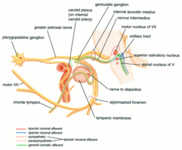Images and videos
Images
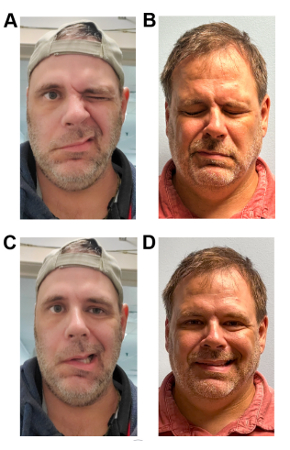
Ramsay Hunt syndrome
Patient with acute Ramsay Hunt syndrome (A and C) that progressed to chronic Ramsay Hunt syndrome (B and D). Photos B and D were taken 14 months after symptom onset. Note the patient’s inability to close right eye (A) and significant smile asymmetry (C), which are both frequently seen in acute Ramsay Hunt syndrome. The patient recovered, but had some signs of aberrant facial nerve regeneration; specifically, note right ocular-oral synkinesis (B) and improved but persistent smile asymmetry (D)
From the collection of Dr Matthew Miller; used with permission
See this image in context in the following section/s:
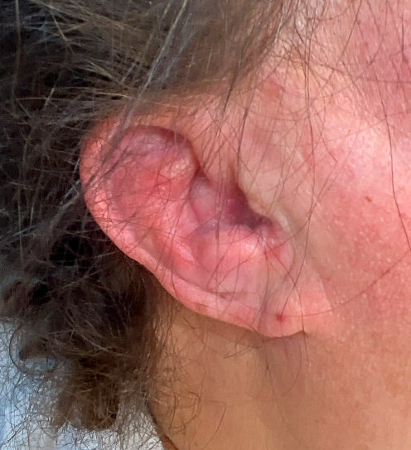
Ramsay Hunt syndrome
Painful vesicular rash in ear in a patient with Ramsay Hunt syndrome
From the collection of Dr Matthew Miller; used with permission
See this image in context in the following section/s:
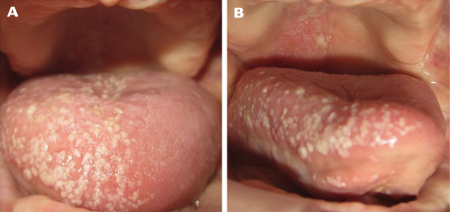
Ramsay Hunt syndrome
A) Vesicular rash on the tongue and B) the palate in a patient with Ramsay Hunt syndrome
Neagu MR et al. Pract Neurol. 2016 Jun;16(3):232; used with permission
See this image in context in the following section/s:
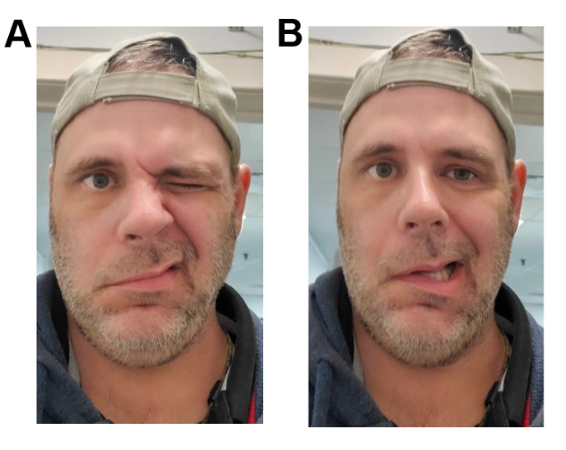
Ramsay Hunt syndrome
Right facial palsy in a man with Ramsay Hunt syndrome. Note the inability to close the right eye (A) and significant smile asymmetry (B), both frequently seen in acute Ramsay Hunt syndrome
From the collection of Dr Matthew Miller; used with permission
See this image in context in the following section/s:

Ramsay Hunt syndrome
Functional anatomy of the facial nerve. Proximally, the four cranial nerve nuclei involved in facial nerve functions are shown at the pontomedullary junction: the motor nucleus of VII, the nucleus of the solitary tract, the superior salivatory nucleus, and the spinal nucleus of V. Special visceral efferent motor fibers from the motor nucleus of VII (solid red line) exit the brainstem and travel through the internal acoustic meatus to enter the bony facial canal and exit through the stylomastoid foramen to supply facial muscles. In Ramsay Hunt syndrome, these fibers are affected as they pass through the geniculate ganglion, disrupting motor functions of the seventh cranial nerve. The solitary tract receives special visceral afferent taste fibers (solid blue line) emanating from the anterior two thirds of the tongue. These fibers travel with the chorda tympani through the petrotympanic fissure (not shown). The cell bodies of these special visceral afferent fibers are in the geniculate ganglion which is the site of varicella zoster virus (VZV) reactivation when vesicles erupt on the tongue. The fibers reach the brainstem via the nervus intermedius and can be affected by local inflammation as they pass the geniculate ganglion. Special visceral efferent parasympathetic fibers (thin dotted red line) to the lacrimal and salivary glands emanate from the superior salivatory nucleus, travel in the nervus intermedius, and branch at the geniculate ganglion into the greater petrosal and chorda tympani nerves. Decreased lacrimation may result from involvement of these fibers as they branch at the level of the geniculate ganglion. Special visceral efferent sympathetic fibers (thick dotted red line) emanate from the carotid plexus on the internal carotid artery and join the greater petrosal nerve as these structures pass through the foramen lacerum (not shown). The sympathetic fibers parallel the parasympathetic fibers as they supply the same areas. The spinal nucleus of V receives general somatic afferent fibers from the geniculate zone of the ear via the chorda tympani. Cell bodies of these neurons are located in the geniculate ganglia and are the site of VZV reactivation in classic Ramsay Hunt syndrome causing vesicular eruptions in geniculate zones
Sweeney CJ et al. J Neurol Neurosurg Psychiatry. 2001 Aug;71(2):149-54; used with permission
See this image in context in the following section/s:

Ramsay Hunt syndrome
External acoustic meatus with multiple vesicular lesions in a patient with Ramsay Hunt syndrome
Ayoub F et al. BMJ Case Rep. 2017 Jul 13;2017:bcr20172198366; used with permission
See this image in context in the following section/s:
Use of this content is subject to our disclaimer
